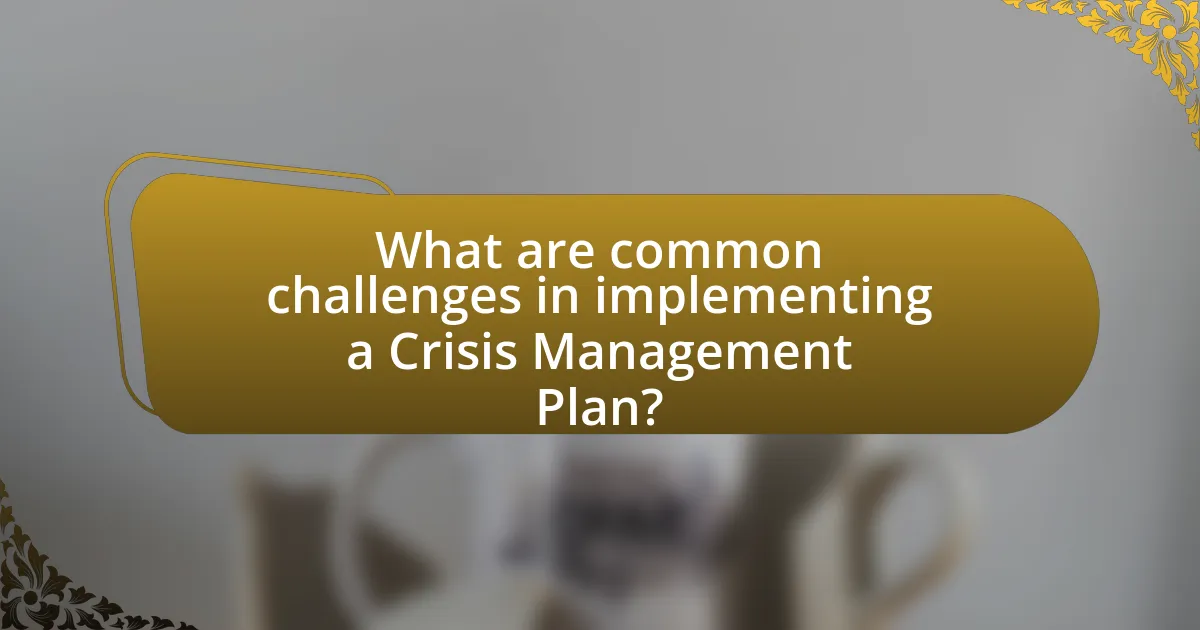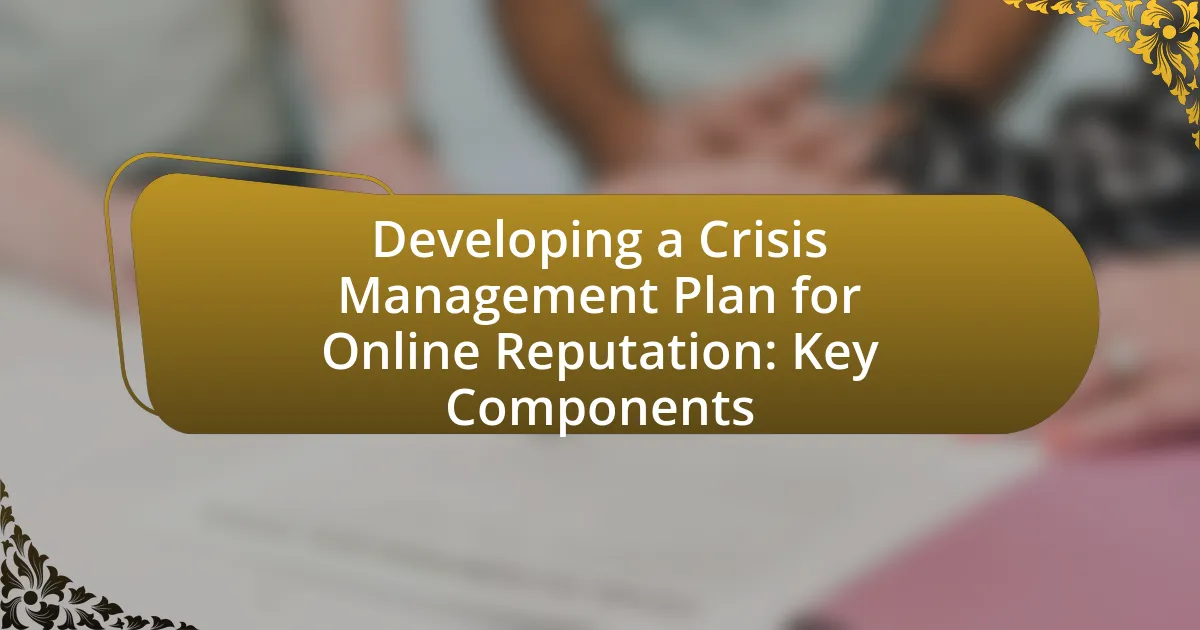A Crisis Management Plan for Online Reputation is a strategic framework aimed at addressing and mitigating negative online incidents that can damage an organization’s reputation. This article outlines the essential components of such a plan, including risk assessment, communication strategies, and response protocols. It highlights the importance of proactive measures in reducing reputational damage and restoring public trust, emphasizing the role of effective communication and stakeholder engagement. Additionally, the article discusses common challenges organizations face during implementation and offers best practices for continuous improvement of the crisis management process.

What is a Crisis Management Plan for Online Reputation?
A Crisis Management Plan for Online Reputation is a strategic framework designed to address and mitigate negative online incidents that can harm an organization’s reputation. This plan typically includes identifying potential risks, establishing communication protocols, and outlining response strategies to manage public perception effectively. For instance, a study by the Harvard Business Review highlights that companies with a proactive crisis management plan can reduce the impact of negative events by up to 50%.
Why is a Crisis Management Plan essential for online reputation?
A Crisis Management Plan is essential for online reputation because it provides a structured approach to addressing and mitigating negative events that can harm a brand’s image. This plan enables organizations to respond swiftly and effectively to crises, minimizing potential damage and restoring public trust. Research indicates that 70% of consumers are more likely to trust a brand that has a clear crisis management strategy in place, highlighting the importance of preparedness in maintaining a positive online presence.
What are the potential risks to online reputation?
Potential risks to online reputation include negative reviews, social media backlash, misinformation, and data breaches. Negative reviews can significantly impact consumer perception, as studies show that 84% of people trust online reviews as much as personal recommendations. Social media backlash can arise from a single misstep, leading to widespread criticism and loss of trust. Misinformation can spread rapidly, damaging credibility and requiring swift corrective action. Data breaches can expose sensitive information, leading to reputational harm and loss of customer trust, with 60% of small businesses closing within six months of a cyberattack. These factors collectively highlight the vulnerabilities that can threaten an organization’s online reputation.
How can a crisis impact a brand’s online presence?
A crisis can significantly damage a brand’s online presence by leading to negative publicity, loss of consumer trust, and decreased engagement across digital platforms. During a crisis, negative information can spread rapidly through social media and news outlets, resulting in a tarnished reputation. For instance, a study by the Institute for Public Relations found that 70% of consumers are less likely to purchase from a brand after a crisis if they perceive the brand’s response as inadequate. This decline in consumer confidence can manifest as reduced website traffic, lower social media interactions, and negative reviews, all of which contribute to a diminished online presence.
What are the key components of a Crisis Management Plan?
The key components of a Crisis Management Plan include risk assessment, communication strategy, response team, action plan, and evaluation process. Risk assessment identifies potential crises that could impact the organization, allowing for proactive measures. The communication strategy outlines how information will be disseminated to stakeholders, ensuring transparency and consistency. A designated response team is crucial for coordinating efforts and making decisions during a crisis. The action plan details specific steps to be taken in response to various scenarios, while the evaluation process assesses the effectiveness of the response and identifies areas for improvement. These components collectively ensure that an organization can effectively manage crises and protect its online reputation.
What role does risk assessment play in the plan?
Risk assessment plays a critical role in the development of a crisis management plan for online reputation by identifying potential threats and vulnerabilities that could impact an organization’s image. This process enables organizations to prioritize risks based on their likelihood and potential impact, allowing for the allocation of resources to mitigate these risks effectively. For instance, a study by the Institute of Risk Management highlights that organizations that conduct thorough risk assessments are 30% more likely to successfully manage crises compared to those that do not. By systematically evaluating risks, organizations can create targeted strategies to address specific issues, ensuring a proactive rather than reactive approach to reputation management.
How do communication strategies fit into the plan?
Communication strategies are integral to a crisis management plan for online reputation as they dictate how information is conveyed to stakeholders during a crisis. These strategies ensure that messaging is clear, consistent, and timely, which is crucial for maintaining trust and credibility. For instance, a study by Coombs (2007) highlights that effective communication can mitigate reputational damage by providing accurate information and addressing concerns promptly. By incorporating structured communication strategies, organizations can better manage public perception and navigate the complexities of a crisis, ultimately protecting their online reputation.

How do you develop an effective Crisis Management Plan?
To develop an effective Crisis Management Plan, organizations must first identify potential crises and assess their impact on online reputation. This involves conducting a thorough risk assessment to pinpoint vulnerabilities and scenarios that could harm the brand. Following this, organizations should establish a clear communication strategy that outlines how to convey messages during a crisis, ensuring that all stakeholders receive timely and accurate information.
Additionally, assigning roles and responsibilities within a crisis management team is crucial for efficient response and coordination. Regular training and simulations should be conducted to prepare the team for real-life scenarios, enhancing their readiness and effectiveness.
Research indicates that companies with a well-defined crisis management plan can mitigate reputational damage by up to 50%, highlighting the importance of proactive planning and preparation.
What steps should be taken to create the plan?
To create a crisis management plan for online reputation, the following steps should be taken: first, conduct a thorough assessment of potential risks and vulnerabilities related to online reputation. This involves identifying key stakeholders, analyzing past incidents, and understanding the digital landscape. Next, establish clear objectives for the plan, such as minimizing damage to reputation and ensuring timely communication.
Then, develop specific strategies and protocols for responding to various crisis scenarios, including social media backlash or negative press. Assign roles and responsibilities to team members to ensure efficient execution during a crisis. Finally, implement training and simulation exercises to prepare the team for real-life situations, and regularly review and update the plan based on new insights or changes in the online environment.
These steps are validated by best practices in crisis management, which emphasize proactive planning and continuous improvement to effectively manage online reputation crises.
How do you identify stakeholders in the crisis management process?
To identify stakeholders in the crisis management process, organizations must first analyze their internal and external environments to pinpoint individuals or groups affected by or capable of influencing the crisis. This involves mapping out key players such as employees, customers, suppliers, investors, regulatory bodies, and the media. Research indicates that effective stakeholder identification enhances communication and response strategies during crises, as highlighted in the study “Stakeholder Theory: The State of the Art” by R. Edward Freeman, which emphasizes the importance of recognizing all parties involved for successful crisis management.
What tools can assist in monitoring online reputation?
Tools that can assist in monitoring online reputation include Google Alerts, Hootsuite, Brand24, and Mention. Google Alerts allows users to receive notifications about new content related to specific keywords, helping track mentions across the web. Hootsuite provides social media management and monitoring capabilities, enabling users to oversee brand mentions and sentiment across various platforms. Brand24 offers real-time monitoring of online mentions and sentiment analysis, allowing businesses to respond promptly to feedback. Mention tracks brand mentions across social media and the web, providing insights into public perception. These tools are widely used for their effectiveness in tracking and managing online reputation.
How can you test and refine the Crisis Management Plan?
To test and refine the Crisis Management Plan, organizations should conduct regular simulations and tabletop exercises that mimic potential crisis scenarios. These exercises allow teams to evaluate the effectiveness of the plan in real-time, identify gaps, and make necessary adjustments. For instance, a study by the Business Continuity Institute found that organizations that regularly test their crisis plans are 50% more likely to respond effectively during an actual crisis. Additionally, gathering feedback from participants after each exercise provides insights into areas for improvement, ensuring the plan remains relevant and effective.
What methods are effective for simulating a crisis scenario?
Effective methods for simulating a crisis scenario include tabletop exercises, role-playing, and scenario planning. Tabletop exercises involve key stakeholders discussing their responses to a hypothetical crisis in a structured environment, which helps identify gaps in the crisis management plan. Role-playing allows participants to act out their responses in real-time, enhancing their ability to react under pressure. Scenario planning involves creating detailed narratives of potential crises, enabling organizations to prepare for various outcomes. These methods are validated by their widespread use in training programs across industries, demonstrating their effectiveness in improving crisis response readiness.
How often should the plan be reviewed and updated?
The plan should be reviewed and updated at least annually. Regular reviews ensure that the crisis management plan remains relevant and effective in addressing current online reputation challenges. According to the Public Relations Society of America, annual reviews help organizations adapt to changes in technology, consumer behavior, and market dynamics, thereby enhancing the plan’s effectiveness in real-world scenarios.

What are common challenges in implementing a Crisis Management Plan?
Common challenges in implementing a Crisis Management Plan include lack of clear communication, insufficient training, and inadequate resources. Clear communication is essential for ensuring that all stakeholders understand their roles during a crisis; however, many organizations struggle to establish effective communication channels. Insufficient training can lead to unprepared staff who are unable to respond appropriately in a crisis situation, as evidenced by a study from the International Journal of Business Continuity and Risk Management, which found that 70% of organizations reported inadequate training as a barrier to effective crisis management. Additionally, inadequate resources, such as budget constraints or lack of access to necessary technology, can hinder the execution of a comprehensive plan, making it difficult for organizations to respond swiftly and effectively to crises.
What obstacles might organizations face during implementation?
Organizations may face several obstacles during the implementation of a crisis management plan for online reputation. Key challenges include resistance to change from employees, lack of adequate training, insufficient resources, and difficulties in communication. Resistance to change can stem from a culture that is not open to new processes, which can hinder the adoption of the crisis management plan. Lack of adequate training may result in employees not fully understanding their roles during a crisis, leading to ineffective responses. Insufficient resources, such as budget constraints or lack of personnel, can limit the effectiveness of the plan. Additionally, communication difficulties can arise if there is no clear protocol for disseminating information during a crisis, which can exacerbate the situation. These obstacles can significantly impede the successful implementation of a crisis management plan, as evidenced by studies indicating that organizations with well-defined training and communication strategies are more effective in managing crises.
How can resistance to change affect the plan’s success?
Resistance to change can significantly hinder the success of a crisis management plan for online reputation. When stakeholders, including employees and management, resist adopting new strategies or processes, it can lead to a lack of alignment and commitment to the plan. This misalignment often results in ineffective implementation, as individuals may not fully engage with or support the necessary actions outlined in the plan. Research indicates that organizations experiencing high levels of resistance to change are 70% more likely to fail in achieving their desired outcomes (Kotter, J.P., “Leading Change,” Harvard Business Review Press, 1996). Therefore, addressing resistance through effective communication and involvement is crucial for the successful execution of a crisis management plan.
What are the implications of inadequate training for staff?
Inadequate training for staff leads to decreased performance and increased errors in their roles. When employees lack proper training, they may struggle to execute tasks effectively, resulting in poor customer service and diminished productivity. A study by the Association for Talent Development found that organizations with comprehensive training programs experience 218% higher income per employee than those with less effective training. Furthermore, inadequate training can contribute to higher employee turnover rates, as staff may feel unprepared and unsupported, leading to dissatisfaction and disengagement. This cycle of poor performance and high turnover can severely impact an organization’s reputation, particularly during a crisis, as untrained staff may mishandle situations that require effective communication and problem-solving skills.
How can organizations overcome these challenges?
Organizations can overcome challenges in developing a crisis management plan for online reputation by implementing a structured approach that includes proactive monitoring, clear communication strategies, and stakeholder engagement. Proactive monitoring allows organizations to identify potential issues before they escalate, as evidenced by a study from the Harvard Business Review, which found that companies that actively monitor their online presence can mitigate reputational damage by 50%. Clear communication strategies ensure that organizations convey accurate information quickly during a crisis, which is crucial for maintaining public trust. Engaging stakeholders, including employees and customers, fosters a supportive environment that can help organizations navigate crises more effectively.
What strategies can enhance employee buy-in for the plan?
To enhance employee buy-in for the crisis management plan, organizations should implement transparent communication, involve employees in the planning process, and provide training on the plan’s importance. Transparent communication fosters trust and ensures that employees understand the rationale behind the plan, which is crucial for their support. Involving employees in the planning process allows them to contribute their insights and feel a sense of ownership, increasing their commitment to the plan. Additionally, providing training emphasizes the plan’s relevance and equips employees with the necessary skills to execute it effectively. Research indicates that organizations with high employee engagement in decision-making processes experience a 20% increase in productivity and a 21% increase in profitability, demonstrating the effectiveness of these strategies in fostering buy-in.
How can effective communication mitigate implementation issues?
Effective communication mitigates implementation issues by ensuring that all stakeholders have a clear understanding of objectives, roles, and processes. When communication is transparent and consistent, it reduces misunderstandings and aligns team efforts, which is crucial during crisis management. Research indicates that organizations with strong communication practices are 50% more likely to achieve project success, as they foster collaboration and prompt feedback, allowing for timely adjustments to strategies. This alignment helps prevent the escalation of issues that could arise from miscommunication, ultimately supporting a more effective crisis management plan for online reputation.
What best practices should be followed for a successful Crisis Management Plan?
A successful Crisis Management Plan should include clear communication, a designated crisis management team, and regular training and simulations. Clear communication ensures that all stakeholders receive timely and accurate information, which is critical during a crisis. A designated crisis management team, composed of individuals with defined roles and responsibilities, facilitates organized and efficient responses. Regular training and simulations prepare the team to handle real-life scenarios effectively, enhancing their readiness and response capabilities. According to a study by the Institute for Crisis Management, organizations with a well-defined crisis management plan are 50% more likely to recover quickly from a crisis.
How can organizations ensure continuous improvement of the plan?
Organizations can ensure continuous improvement of the crisis management plan by implementing regular reviews and updates based on feedback and performance metrics. This involves conducting post-crisis evaluations to analyze the effectiveness of the plan, gathering insights from stakeholders, and integrating lessons learned into future iterations. Research indicates that organizations that engage in systematic reviews, such as the one outlined in the “Crisis Management: A Comprehensive Guide” by Coombs and Holladay, demonstrate enhanced resilience and adaptability in their crisis response strategies.
What role does feedback play in refining the crisis management process?
Feedback is essential in refining the crisis management process as it provides critical insights into the effectiveness of strategies and actions taken during a crisis. By systematically gathering feedback from stakeholders, organizations can identify strengths and weaknesses in their response efforts, allowing for adjustments that enhance future performance. For instance, after a crisis, analyzing feedback can reveal gaps in communication or resource allocation, which can be addressed in subsequent crisis management plans. This iterative process of incorporating feedback leads to improved preparedness and response capabilities, ultimately safeguarding an organization’s online reputation.

Leave a Reply